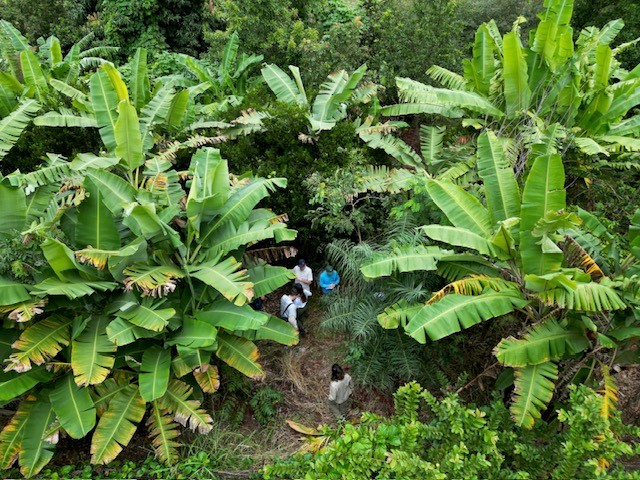Embracing Sustainability: Fashion’s Role in Climate Week
- Tapestry is committed to regenerative agriculture, biodiversity preservation, resource efficiency, and circularity.
- They have restored 11,000 acres of pasture through a partnership with the World Wildlife Fund.
- They are investing in renewable energy and implementing circular design practices.
- None.
How Tapestry is working toward a future that is both beautiful and responsible
NORTHAMPTON, MA / ACCESSWIRE / September 21, 2023 / There may not be street-style photographers, but NYC Climate Week has red carpets, VIPs and plenty of insider gossip! This annual global event dedicated to raising awareness and taking action on climate change is one of the most widely watched environmental moments in the world…kind of like seeing who's sitting front row at NYFW. Climate Week is held in partnership with the United Nations during the start of the General Assembly, a series of sessions on topics crucial to the global population from September to December every year.
As a fashion company, it's essential that we understand our role in this crucial initiative. You may have heard of Tapestry's "ESG Strategy" (ESG stands for environmental, social, and governance) - what we call the Fabric of Change. We think of this as a blueprint for how we'll weave together our business ambitions with our commitments to overcome some of the most pressing issues facing our industry and society at large. During Climate Week, the "E" or sustainability part of our blueprint comes into focus as we listen, learn, and share how the fashion industry can lead the way to a future that is both beautiful and responsible.
Real change requires bold action. Our journey to lasting, sustainable change includes deep analysis of all of our environmental impacts - emissions, water use and waste to landfill, as well as renewable energy adoption across our operations, environmentally preferred materials and a more resilient supply chain. As the impacts of climate change become more prominent, and in anticipation of the climate challenges of tomorrow, we are working to create a more responsible business model today.
Tapestry has four main focus areas, including regenerative agriculture, biodiversity, resource efficiency, and circularity. Scroll down to read more about about efforts in each area.
Regenerative agriculture is a set of farming and grazing techniques that provides environmental benefits, such as soil health and fertility, biodiversity, water quality, reduced impact on climate change, and social and economic support. Within food and farming systems, standard practices often strip soil of its nutrients and require external inputs to the environment that may cause long term harm. Regenerative agriculture is a different approach to these systems that aims to maintain and rejuvenate grasslands, increase biological diversity, soil health and productivity, and could lead to increased carbon absorption. At Tapestry, we want to source materials that don't just mitigate harm but rather have a real, positive impact on their environment; our partnership with organizations like the Savory Institute that are leading the charge towards regenerative agriculture reflect this commitment.
Regenerative agriculture is part of our broader commitment to improving the sustainability of our leather supply chain. For example, we've committed to sourcing at least
You can learn more about regenerative grazing here.
Want to see regenerative leather in action? Check out Coach's Rogue bag that is made with regenerative leather.
Biodiversity: Fashion's Connection to Nature
Biodiversity - essentially all living things on Earth - is the cornerstone of a healthy planet is the cornerstone of a healthy planet, and fashion can play a crucial role in preserving it. The fashion industry relies on various natural fibers, such as cotton, viscose, hemp, and silk, which are derived from different plant species. Tapestry recognizes the impact our business has on our natural environments and know that we have a responsibility to reduce impact in a meaningful and measurable way.
We aim to attain
In FY2022, we launched a
In the first year, the project has restored nearly 11,000 acres of pasture and riparian areas and WWF has held seven training courses to initiate seed collection community projects with 125 rural people reached through these courses (
You can read more about the WWF partnership here and here.
Resource Efficiency: Doing More with Less
Resource efficiency is a critical aspect of combating climate change, and fashion can contribute by optimizing its production processes. By reducing waste and conserving resources, we can minimize our carbon footprint. This means adopting practices like lean manufacturing, where we only produce what is necessary, and using advanced technologies to maximize material utilization.
Tapestry has committed to procuring
In December of 2022, we joined The Fashion Pact's Collective Virtual Power Purchasing Agreement (CVPPA) alongside 11 other brands. In doing so, we commit ourselves to accelerate renewable electricity adoption by investing in new clean energy infrastructure. In FY2022, Tapestry also procured
We also are working to engage directly with our suppliers to support their transition to renewable energy. According to Higg FEM and survey responses from LWG audits, our suppliers reported that
Circularity: Closing the Loop
Circularity in fashion is about creating a closed-loop system where products are designed, produced, and disposed of in a way that minimizes waste and extends the lifespan of fashion items. By embracing circularity, we reduce the need for constant production of new garments and decrease the environmental impact of fashion.
Longevity is a key factor in all products made by Tapestry's iconic house of brands. We see this as an expression of a future that is both beautiful and responsible. This is one of the reasons Tapestry is staying the course on using leather as a component of so many of our products: Leather is one of the most durable natural materials that can last for generations.
In FY2023, Tapestry participated in an
On a brand level, Coach has offered repairs for their products for 30 years. This repair program supplements what is now a full portion of the brand's business: Coach (Re)Loved. The (Re)Loved program takes Coach products and either restores them to their original glory, upcrafts them into a new, one-of-a-kind product, or repurposes damaged pieces into completely new products. The program has given over 10,000 products a second life and is currently being expanded into China, Japan, and the United Kingdom.
The launch of Coachtopia, a sub-brand of Coach that is driven by circular design, is another example of how Coach is implementing circularity into their business model. Coachtopia's products are made from primarily recycled materials and designed to be repaired, reworked, and reimagined.
kate spade new york has partnered with ThredUp, one of the largest apparel resale platforms in the world, to create the Pre-Loved Program, in which customers can turn gently used clothes for kate spade shopping credit. In Spring 2023, to coincide with the brands 30th anniversary, we took new steps on our journey to drive progress including reimagining the Sam Icon bag using
Tapestry is a member of the Ellen MacArthur Foundation's Fashion Advisory Board, an international organization working to accelerate the transition towards a circular economy, as part of our commitment to innovating and scaling circular business models. As Network Partners as well as members of the foundation, we hope to find areas of opportunity within our businesses and within the fashion industry to implement circularity into how we operate.
Climate change affects us all, and it's imperative that we take concrete steps to address it. Let's embrace these sustainable practices not just during Climate Week but as a part of our everyday operations. By doing so, we can pave the way for a more responsible fashion industry and make a positive impact on the world we live in. Tapestry is shaping lifestyles to contribute to a culture of change that will help us realize a better-made future. We can use our collective strengths to help make the fashion industry more sustainable.

View additional multimedia and more ESG storytelling from Tapestry, Inc. on 3blmedia.com.
Contact Info:
Spokesperson: Tapestry, Inc.
Website: https://www.3blmedia.com/profiles/tapestry-inc
Email: info@3blmedia.com
SOURCE: Tapestry, Inc.
View source version on accesswire.com:
https://www.accesswire.com/786239/embracing-sustainability-fashions-role-in-climate-week







